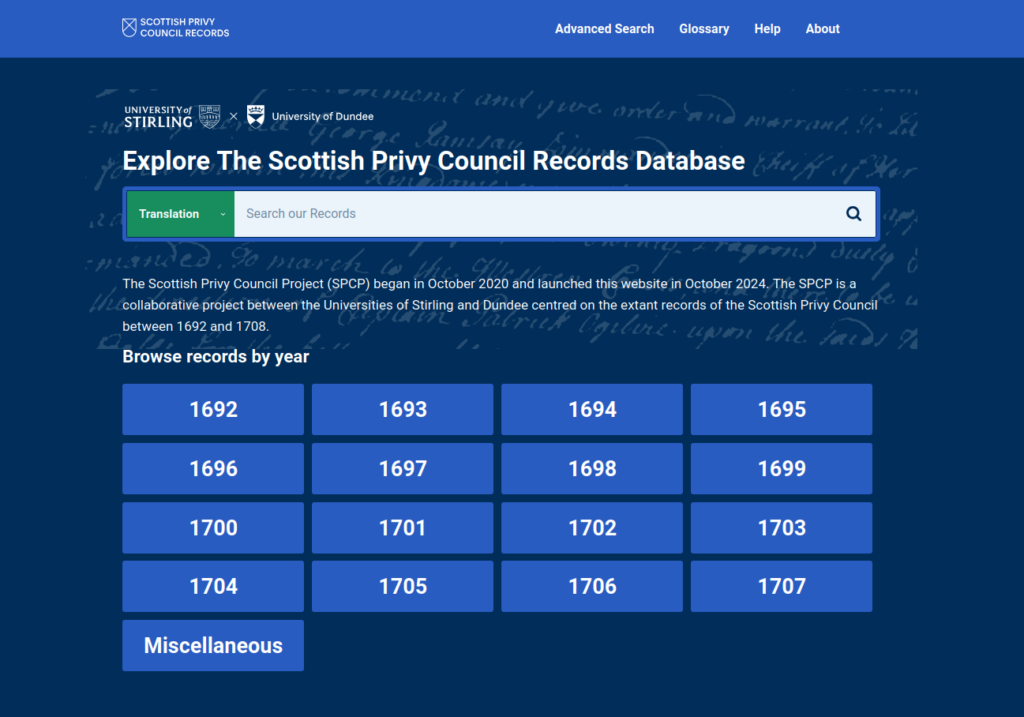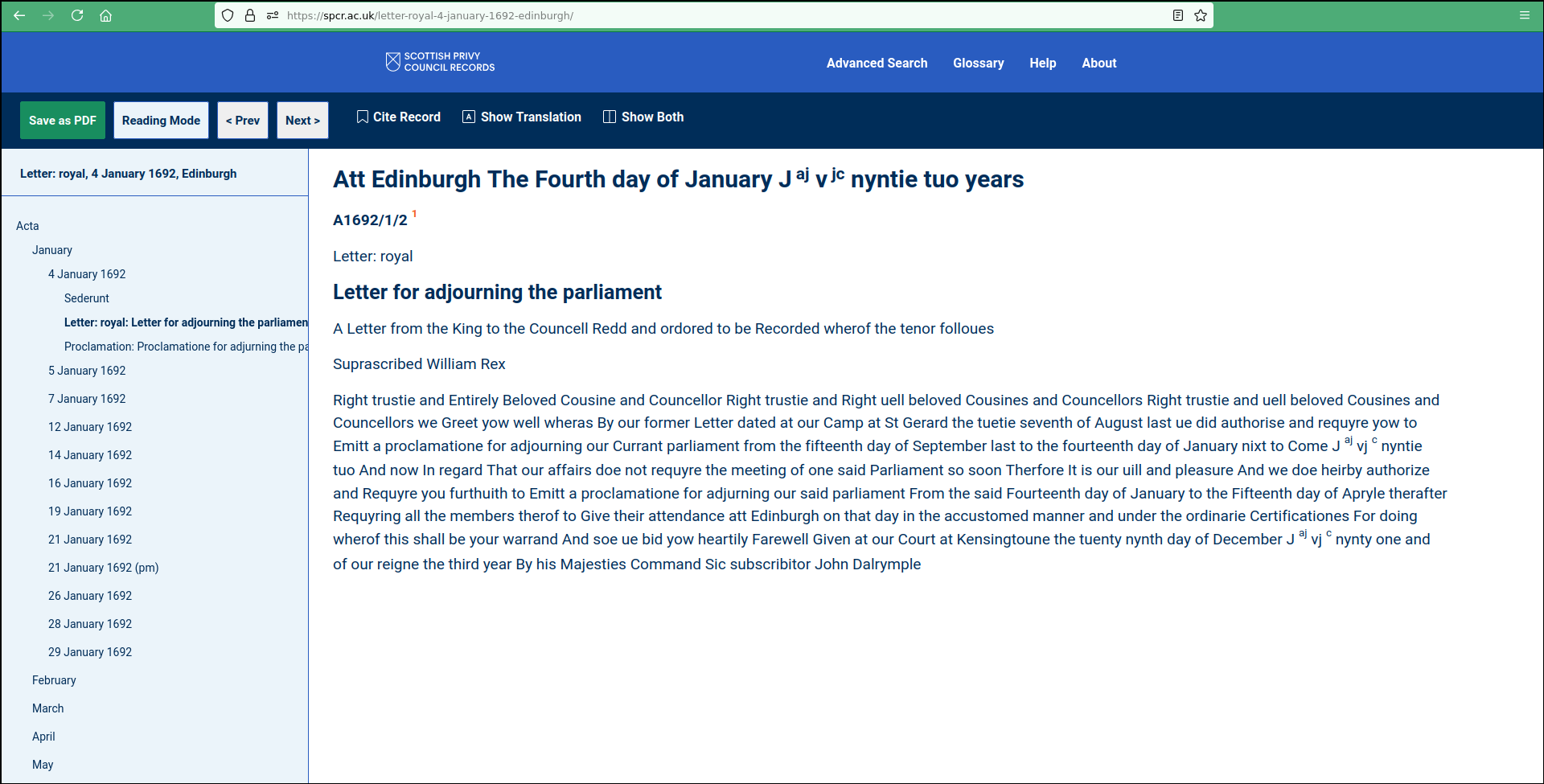What does SPCR contain?
SPCR contains the formal records of the Scottish Privy Council between 1692 and the abolition of the Council in 1708. The original manuscripts exist as large bound volumes, and are held in the National Records of Scotland, Edinburgh (although there are no surviving volumes for 1708). Since the Council was the main organ of executive government in pre-Union Scotland, these records contain a wealth of information on virtually all aspects of public life, from war and peace to taxation to humdrum matters of day-to-day administration.
The records are split into two main classes:
To differentiate between these two series, reference numbers in SPCR begin either with ‘A’ (Acta) or ‘D’ (Decreta). It is important to note, however, that the division between ‘public’ and ‘private’ business was not always clear-cut, nor strictly enforced. Therefore, some matters apparently pertaining to private affairs are recorded in the Acta, while ostensibly public business can occasionally be found in the Decreta.
While full transcriptions of the Acta and Decreta form the core of SPCR, the database also contains ‘Miscellaneous’ material. This incorporates supplementary papers related to the Privy Council, but lying outside its formal records. For the most part, the ‘Miscellaneous’ material comprises draft minutes and loose working papers collected in NRS series PC12 (running to ten boxes), but it also involves some journals and additional loose papers found in private archives, also housed in NRS. Unlike the Acta and Decreta, the ‘Miscellaneous’ papers have not been transcribed; instead, SPCR provides detailed calendars (summaries) of their contents, including some for 1708.

Home page
How to browse
The most straightforward way to access SPCR is via the Browse function. To access this, simply click on one of the blue tiles on the Home page, which are labelled by year. Clicking on a tile will take you to the records for that particular year. From there, the hierarchical navigation pane on the left-hand side of the screen can be used to move between Acta and Decreta, and then to drill down to individual months, dates, and, finally, records (see Prev/Next buttons in Record view below). If you wish to return to the Home page and browse other years, click ‘Scottish Privy Council Records’ to the top left. Underneath the blue tiles on the Home page a reference indicates the last record viewed and a button allows you to continue where you previously finished.
Once you have located a specific record, you will see various pieces of information on-screen. At the top of each record is the date on which it was generated, followed by the reference number, the classification tag (indicating what type of record it is), and the record title as given in the original manuscript. Below the title is the text of the entry, transcribed verbatim from the manuscripts, retaining original spelling and punctuation but with most contractions silently expanded.
How to search
There are two methods of searching:
Basic Search
SPCR can also be accessed using the Basic Search function. This can be done using the Search box on the Home page. You can choose to search either the original manuscript record or the parallel translation into modern English (Basic Search defaults to the latter). Since the original language of the records has been retained in ‘Manuscript’, spelling tends to be irregular, and a small amount of the record is also in Latin. ‘Translation’ renders all this in modern English, and also standardises personal names and (where identifiable) place-names. Searching ‘Translation’ is therefore likely to be more reliable. Please note, however, that adding the translation text is an on-going process and those records not yet translated will initially appear with a duplicate of the manuscript text.
Basic searching can be for a single word, an SPCR reference number, or a phrase. A single word search, e.g. ‘book’, will search documents for that word, and include words using it as a stem, such as ‘books’ or ‘booked’. Note that this search is case insensitive.
Searching for phrases means putting double quotes round two or more words, for example “St Andrews”. Searches with quotes are still case insensitive.
To find a record associated with a specific SPCR reference number, enter it within the search box. If you enter a full reference number – e.g. A1698/4/3 – the search engine will produce just that record. Entering part of reference will yield all records containing that string in some configuration. So, for example, ‘A1698/4′ will produce all records beginning with those digits (likely to be all Acta records from April 1698), while ‘/6/3′ will take you to all records that contain those digits somewhere in their reference (likely to be various records from June, regardless of year or whether Acta or Decreta).
Search results are displayed chronologically, with no separation of hits into Acta and Decreta.
Advanced Search
The Advanced Search function operates on the same basic principle as Basic Search but allows you to specify a precise date-range, or to limit your search to specific record classifications (e.g. ‘Warrants’ or ‘Proclamations’).
Record view

Record view for January 1692
Once you are viewing a particular record, you have access to a number of useful functions. The dark blue ribbon at the top of the record contains four clickable buttons that allow you to: save the current record as a PDF; switch to ‘Reading Mode’ (which strips away all the surrounding material and displays only the text of the record); move to the immediately preceding record in the hierarchy; and move to the next record. Note that after you create a PDF you may need to refresh the page before proceeding.
Next to these buttons are three further clickable features. ‘Cite Record’ provides you with citation information for the record you are viewing. ‘Show Manuscript/Translation’ allows you to toggle between the original and modernised text of the record. And ‘Show Both’ pulls up both versions of the record side-by-side.
Links in the light blue panel at the top of the screen allow you to jump to other parts of the website, specifically the ‘Advanced Search’. ‘Glossary’, ‘Help’ and ‘About’ pages.
Finally, each page contains a number of clickable footnotes. Clicking on these will display the contents of the note. These are generally reference information indicating where the original record can be found within the Privy Council’s manuscript books, but some also contain editorial information, indicating things like doubtful readings, deletions, and textual insertions, or comments from the editors. Footnotes must be closed before you can proceed to the next record.